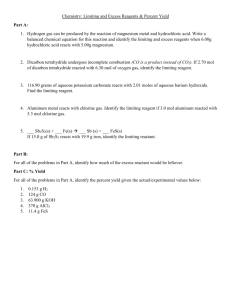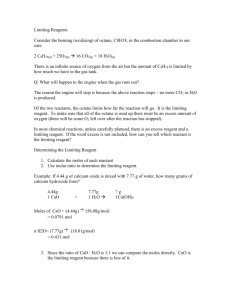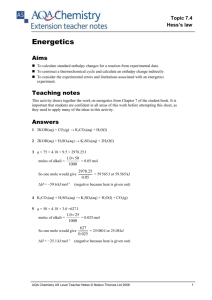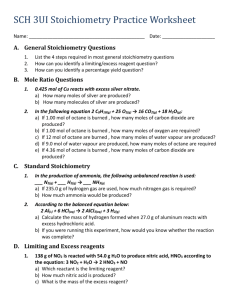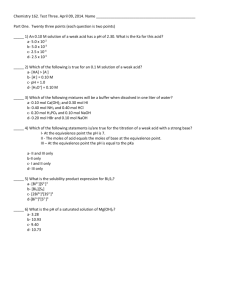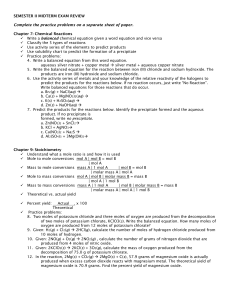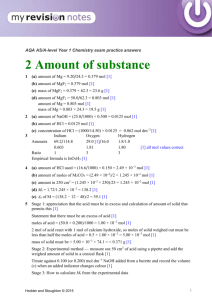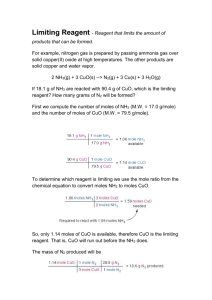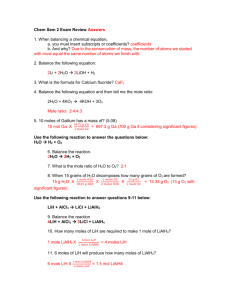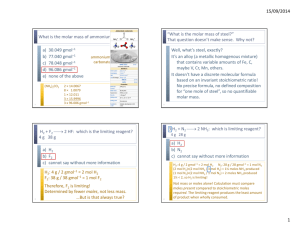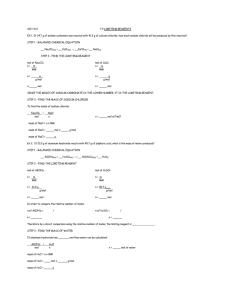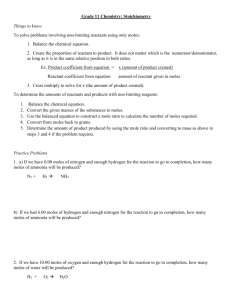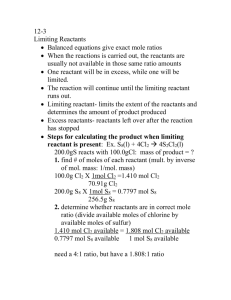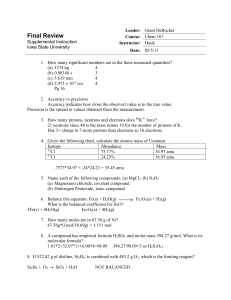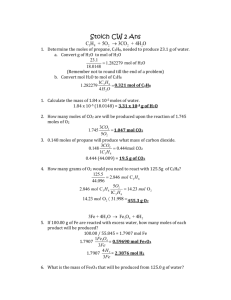Worksheet 3b answers - Iowa State University
advertisement
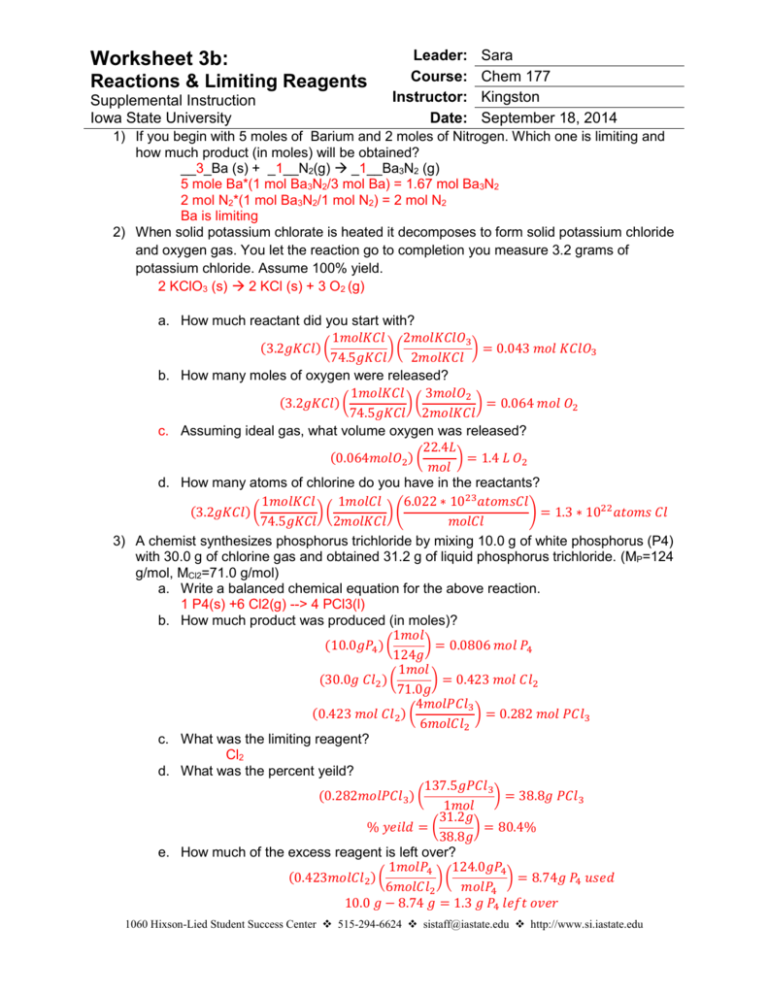
Worksheet 3b: Reactions & Limiting Reagents Supplemental Instruction Iowa State University Leader: Course: Instructor: Date: Sara Chem 177 Kingston September 18, 2014 1) If you begin with 5 moles of Barium and 2 moles of Nitrogen. Which one is limiting and how much product (in moles) will be obtained? __3_Ba (s) + _1__N2(g) _1__Ba3N2 (g) 5 mole Ba*(1 mol Ba3N2/3 mol Ba) = 1.67 mol Ba3N2 2 mol N2*(1 mol Ba3N2/1 mol N2) = 2 mol N2 Ba is limiting 2) When solid potassium chlorate is heated it decomposes to form solid potassium chloride and oxygen gas. You let the reaction go to completion you measure 3.2 grams of potassium chloride. Assume 100% yield. 2 KClO3 (s) 2 KCl (s) + 3 O2 (g) a. How much reactant did you start with? 1𝑚𝑜𝑙𝐾𝐶𝑙 2𝑚𝑜𝑙𝐾𝐶𝑙𝑂3 (3.2𝑔𝐾𝐶𝑙) ( )( ) = 0.043 𝑚𝑜𝑙 𝐾𝐶𝑙𝑂3 74.5𝑔𝐾𝐶𝑙 2𝑚𝑜𝑙𝐾𝐶𝑙 b. How many moles of oxygen were released? 1𝑚𝑜𝑙𝐾𝐶𝑙 3𝑚𝑜𝑙𝑂2 (3.2𝑔𝐾𝐶𝑙) ( )( ) = 0.064 𝑚𝑜𝑙 𝑂2 74.5𝑔𝐾𝐶𝑙 2𝑚𝑜𝑙𝐾𝐶𝑙 c. Assuming ideal gas, what volume oxygen was released? 22.4𝐿 (0.064𝑚𝑜𝑙𝑂2 ) ( ) = 1.4 𝐿 𝑂2 𝑚𝑜𝑙 d. How many atoms of chlorine do you have in the reactants? 1𝑚𝑜𝑙𝐾𝐶𝑙 1𝑚𝑜𝑙𝐶𝑙 6.022 ∗ 1023 𝑎𝑡𝑜𝑚𝑠𝐶𝑙 (3.2𝑔𝐾𝐶𝑙) ( )( )( ) = 1.3 ∗ 1022 𝑎𝑡𝑜𝑚𝑠 𝐶𝑙 74.5𝑔𝐾𝐶𝑙 2𝑚𝑜𝑙𝐾𝐶𝑙 𝑚𝑜𝑙𝐶𝑙 3) A chemist synthesizes phosphorus trichloride by mixing 10.0 g of white phosphorus (P4) with 30.0 g of chlorine gas and obtained 31.2 g of liquid phosphorus trichloride. (MP=124 g/mol, MCl2=71.0 g/mol) a. Write a balanced chemical equation for the above reaction. 1 P4(s) +6 Cl2(g) --> 4 PCl3(l) b. How much product was produced (in moles)? 1𝑚𝑜𝑙 (10.0𝑔𝑃4 ) ( ) = 0.0806 𝑚𝑜𝑙 𝑃4 124𝑔 1𝑚𝑜𝑙 (30.0𝑔 𝐶𝑙2 ) ( ) = 0.423 𝑚𝑜𝑙 𝐶𝑙2 71.0𝑔 4𝑚𝑜𝑙𝑃𝐶𝑙3 (0.423 𝑚𝑜𝑙 𝐶𝑙2 ) ( ) = 0.282 𝑚𝑜𝑙 𝑃𝐶𝑙3 6𝑚𝑜𝑙𝐶𝑙2 c. What was the limiting reagent? Cl2 d. What was the percent yeild? 137.5𝑔𝑃𝐶𝑙3 (0.282𝑚𝑜𝑙𝑃𝐶𝑙3 ) ( ) = 38.8𝑔 𝑃𝐶𝑙3 1𝑚𝑜𝑙 31.2𝑔 % 𝑦𝑒𝑖𝑙𝑑 = ( ) = 80.4% 38.8𝑔 e. How much of the excess reagent is left over? 1𝑚𝑜𝑙𝑃4 124.0𝑔𝑃4 (0.423𝑚𝑜𝑙𝐶𝑙2 ) ( )( ) = 8.74𝑔 𝑃4 𝑢𝑠𝑒𝑑 6𝑚𝑜𝑙𝐶𝑙2 𝑚𝑜𝑙𝑃4 10.0 𝑔 − 8.74 𝑔 = 1.3 𝑔 𝑃4 𝑙𝑒𝑓𝑡 𝑜𝑣𝑒𝑟 1060 Hixson-Lied Student Success Center 515-294-6624 sistaff@iastate.edu http://www.si.iastate.edu







